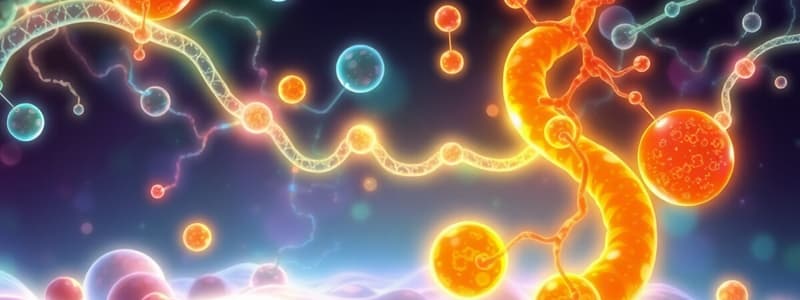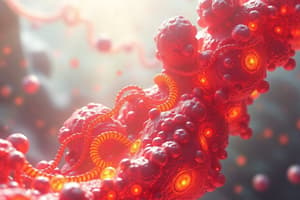Podcast
Questions and Answers
The primary purpose of glycolysis in red blood cells (RBCs) is to:
The primary purpose of glycolysis in red blood cells (RBCs) is to:
- Synthesize glycogen for energy storage.
- Facilitate protein synthesis.
- Generate energy anaerobically. (correct)
- Produce fatty acids for membrane synthesis.
Which of the following is the correct net production of ATP during glycolysis from one molecule of glucose?
Which of the following is the correct net production of ATP during glycolysis from one molecule of glucose?
- 2 ATP (correct)
- 38 ATP
- 36 ATP
- 4 ATP
During glycolysis, glucose is ultimately converted into:
During glycolysis, glucose is ultimately converted into:
- Acetyl-CoA
- Pyruvate (correct)
- Citrate
- Lactate
Which enzyme catalyzes the committed step in glycolysis and is a key regulatory point?
Which enzyme catalyzes the committed step in glycolysis and is a key regulatory point?
What is the role of NAD+ in the glyceraldehyde-3-phosphate dehydrogenase (GAPDH) reaction during glycolysis?
What is the role of NAD+ in the glyceraldehyde-3-phosphate dehydrogenase (GAPDH) reaction during glycolysis?
Which of the following conditions inhibits phosphofructokinase-1 (PFK-1)?
Which of the following conditions inhibits phosphofructokinase-1 (PFK-1)?
In anaerobic glycolysis, pyruvate is converted to:
In anaerobic glycolysis, pyruvate is converted to:
What is the significance of 2,3-bisphosphoglycerate (2,3-BPG) in red blood cells?
What is the significance of 2,3-bisphosphoglycerate (2,3-BPG) in red blood cells?
Which pathway is responsible for generating NADPH and pentose phosphates?
Which pathway is responsible for generating NADPH and pentose phosphates?
A deficiency in pyruvate kinase in red blood cells primarily leads to:
A deficiency in pyruvate kinase in red blood cells primarily leads to:
Which of the following represents a step in glycolysis that is irreversible and requires a unique enzyme to bypass it in gluconeogenesis?
Which of the following represents a step in glycolysis that is irreversible and requires a unique enzyme to bypass it in gluconeogenesis?
What is the metabolic fate of excess pentose phosphates produced in the pentose phosphate pathway?
What is the metabolic fate of excess pentose phosphates produced in the pentose phosphate pathway?
How does increased lactate production affect blood pH during intense exercise?
How does increased lactate production affect blood pH during intense exercise?
Which enzyme deficiency in red blood cells can lead to increased susceptibility to oxidative damage due to the cell's reduced ability to handle oxidative stress?
Which enzyme deficiency in red blood cells can lead to increased susceptibility to oxidative damage due to the cell's reduced ability to handle oxidative stress?
What is the primary function of the enzyme aldolase in glycolysis?
What is the primary function of the enzyme aldolase in glycolysis?
Which of the following steps in glycolysis requires the input of ATP?
Which of the following steps in glycolysis requires the input of ATP?
How does the presence of insulin affect glycolysis?
How does the presence of insulin affect glycolysis?
Under what cellular conditions would gluconeogenesis be favored over glycolysis?
Under what cellular conditions would gluconeogenesis be favored over glycolysis?
Which of the following molecules directly donates a phosphate group to ADP to form ATP in substrate-level phosphorylation during glycolysis?
Which of the following molecules directly donates a phosphate group to ADP to form ATP in substrate-level phosphorylation during glycolysis?
In the context of glycolysis, what is the significance of the Cori cycle?
In the context of glycolysis, what is the significance of the Cori cycle?
How does a shift from aerobic to anaerobic conditions affect the rate of glycolysis?
How does a shift from aerobic to anaerobic conditions affect the rate of glycolysis?
What is the role of triose phosphate isomerase in glycolysis?
What is the role of triose phosphate isomerase in glycolysis?
Which of the following is a symptom associated with inherited errors in glycolytic enzymes?
Which of the following is a symptom associated with inherited errors in glycolytic enzymes?
Where does glycolysis occur in eukaryotic cells?
Where does glycolysis occur in eukaryotic cells?
What is the primary function of hexokinase in glycolysis?
What is the primary function of hexokinase in glycolysis?
Flashcards
What is Glycolysis?
What is Glycolysis?
The metabolic pathway that breaks down glucose into pyruvate, generating ATP and NADH.
Why is glycolysis vital for RBCs?
Why is glycolysis vital for RBCs?
Glycolysis is essential for energy production in red blood cells because they lack mitochondria and rely on anaerobic metabolism.
Why is glycolysis important for the brain?
Why is glycolysis important for the brain?
Glycolysis is crucial for the brain's energy supply, especially during intense activity or when other fuel sources are limited.
What is the end product of glycolysis?
What is the end product of glycolysis?
Signup and view all the flashcards
What is the role of PFK-1?
What is the role of PFK-1?
Signup and view all the flashcards
How does ATP regulate PFK-1?
How does ATP regulate PFK-1?
Signup and view all the flashcards
What happens to pyruvate in anaerobic conditions?
What happens to pyruvate in anaerobic conditions?
Signup and view all the flashcards
What is the role of 2,3-BPG in RBCs?
What is the role of 2,3-BPG in RBCs?
Signup and view all the flashcards
What key products are generated by the pentose phosphate pathway?
What key products are generated by the pentose phosphate pathway?
Signup and view all the flashcards
What is the result of deficiencies in pyruvate kinase?
What is the result of deficiencies in pyruvate kinase?
Signup and view all the flashcards
Study Notes
Glycolysis Introduction
- Glycolysis is essential for energy in red blood cells (RBCs) because they operate anaerobically.
- It is crucial for the brain's energy needs
- Glycolysis starts with glucose and results in the generation of pyruvate.
Tracking Carbons
- During glycolysis, a glucose molecule is broken down into two molecules of pyruvate.
- This involves a series of enzymatic reactions where carbon atoms are rearranged, leading to the production of ATP and NADH.
Irreversible Steps of Glycolysis
- Some steps in glycolysis are irreversible.
- Special enzymes are required to reverse these steps in reactions like gluconeogenesis.
Glyceraldehyde 3-Phosphate Dehydrogenase (GAPDH)
- In step 1, glyceraldehyde-3-P (RCHO) interacts with GAPDH's active site sulfhydryl group and forms thiohemiacetal adduct.
- In step 2, the thiohemiacetal is oxidized into a thioester by NAD+, which is then reduced to NADH.
- NAD+ is bound in the active site of the enzyme.
- In step 3, a phosphorylase reaction cleaves the carbon-sulfur bond after a phosphate enters the active site.
- The 3-phosphoglycerate group is displaced, leading to the formation of 1,3-bisphosphoglycerate.
- Lastly, the 1,3-bisphosphoglycerate regenerates the sulfhydryl group.
- Enzyme exchange consists of NADH for NAD+.
Phosphofructokinase-1 Regulation
- Phosphofructokinase-1 (PFK-1) acts as the main regulatory point in glycolysis by controlling the conversion of fructose-6-phosphate (Fru-6-P) to fructose-1,6-bisphosphate (Fru-1,6-BP).
- PFK-1 indirectly affects the levels of glucose-6-phosphate (Glc-6-P) and inhibits hexokinase activity.
- Achieved through the reaction of phosphoglucose isomerase.
- ATP serves as both a substrate and an allosteric inhibitor of PFK-1.
- Providing essential control over its activity, especially in red blood cells (RBCs).
- PFK-1's activity varies based on the energy status of the cell.
Change in Free Energy
- Glycolysis, pyruvate oxidation, and the citric acid cycle are linked by changes in free energy.
Anaerobic Glycolysis
- Anaerobic glycolysis is the process of glucose utilization in red blood cells.
- The result of the process is the production of lactate.
Anaerobic Metabolism in Red Blood Cells
- In red blood cells (RBCs), glucose is broken down into 2 pyruvate molecules through a series of reactions.
- Pyruvate is converted to lactic acid through anaerobic glycolysis.
- This process generates ATP, which is used to maintain electrochemical and ion gradients across the RBC plasma membrane.
- An intermediate of glycolysis, 10-20% of 1,3-bisphosphoglycerate, is diverted to produce 2,3-bisphosphoglycerate (2,3-BPG).
- 2,3-BPG is a regulator of oxygen affinity for hemoglobin.
- 10% of glucose metabolism is shunted towards the pentose phosphate pathway to protect from oxidative stress and provide NADPH.
Pentose Phosphate Pathway
- The irreversible redox stage generates NADPH and pentose phosphates.
- In the reversible interconversion stage excess pentose phosphates are recycled into glycolytic intermediates.
Deficiencies in Glycolysis and Consequences for RBCs
- Errors in glycolysis lead to hemolytic anemias.
- Pyruvate kinase deficiency and G6PDH deficiency (from the pentose phosphate pathway) are common examples that cause hemolytic anemia.
- Diagnosis of these deficiencies relies on evaluating levels of enzymes/metabolites, measuring enzyme activity, and conducting genetic testing.
- Deficiencies lead to a diverse range of consequences, including varying degrees of cellular damage.
- Insufficient ATP leads to the inability to maintain ion gradients and maintain cell shape.
- G6PDH deficiency can cause significant lipid peroxidation and GSH loss because of a failure to recycle it.
- High levels of 2,3-bisphosphoglycerate (2,3-BPG) can decrease oxygen affinity, diminishing the capacity of tissues to receive oxygen.
Studying That Suits You
Use AI to generate personalized quizzes and flashcards to suit your learning preferences.




